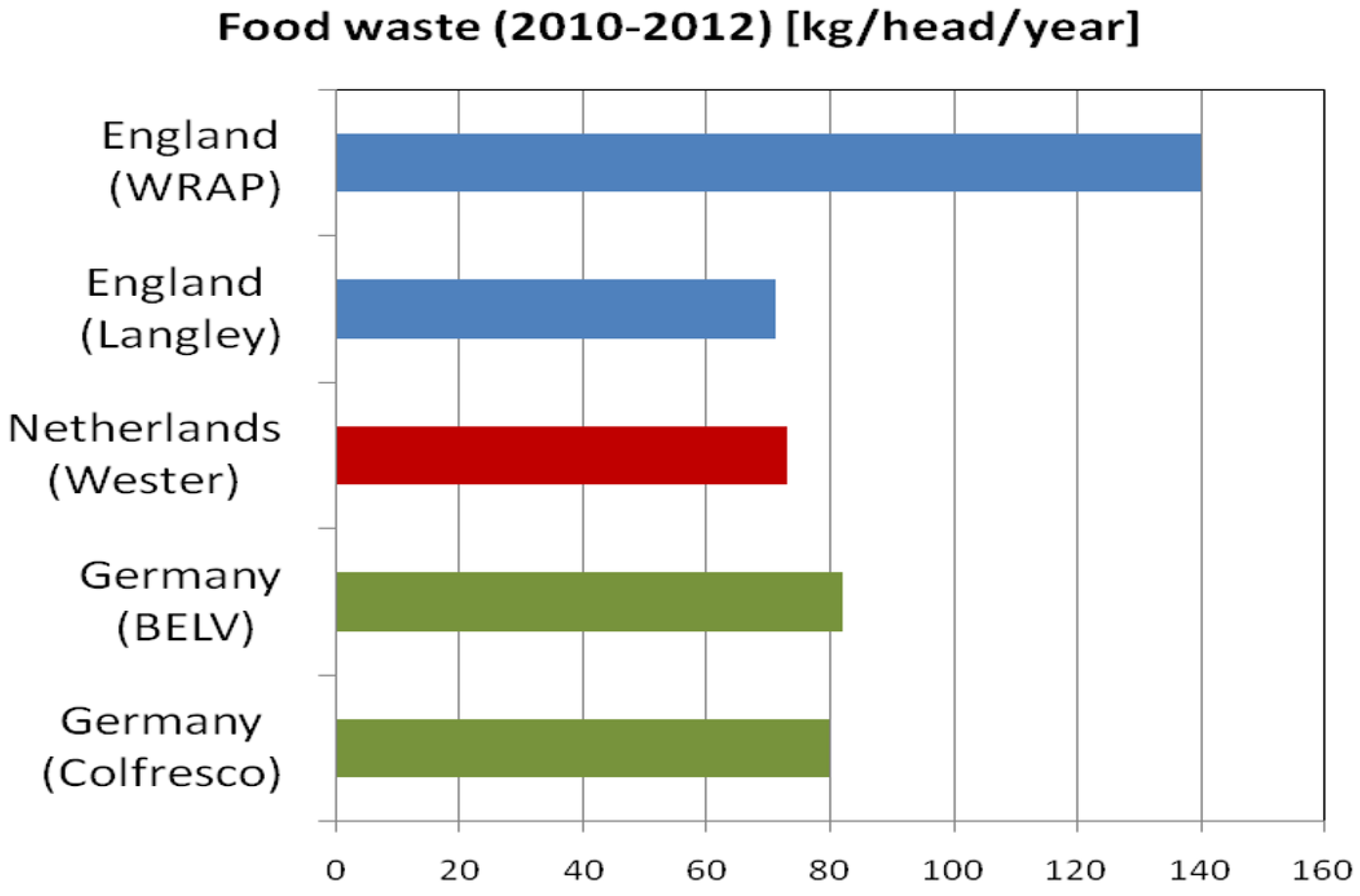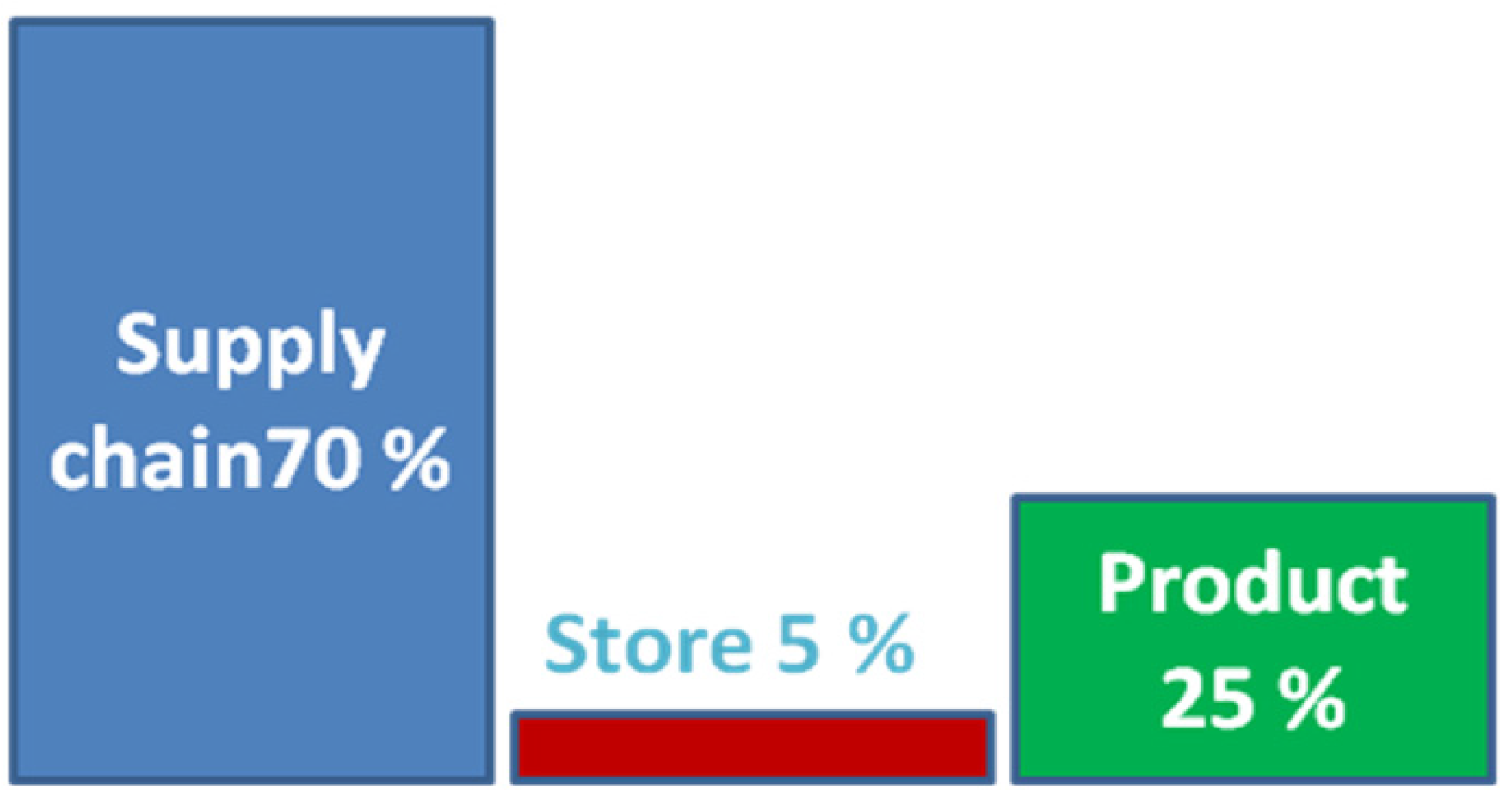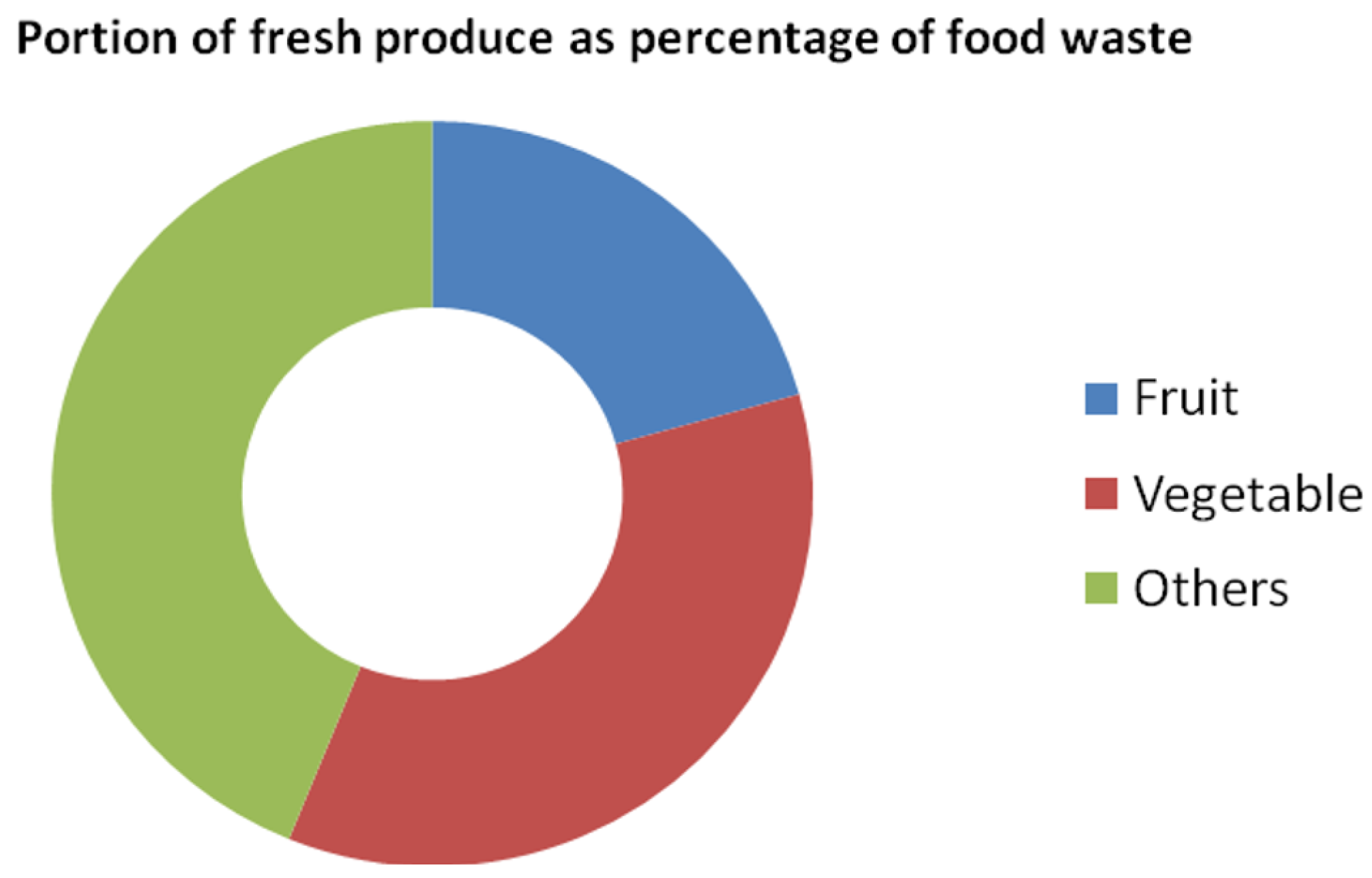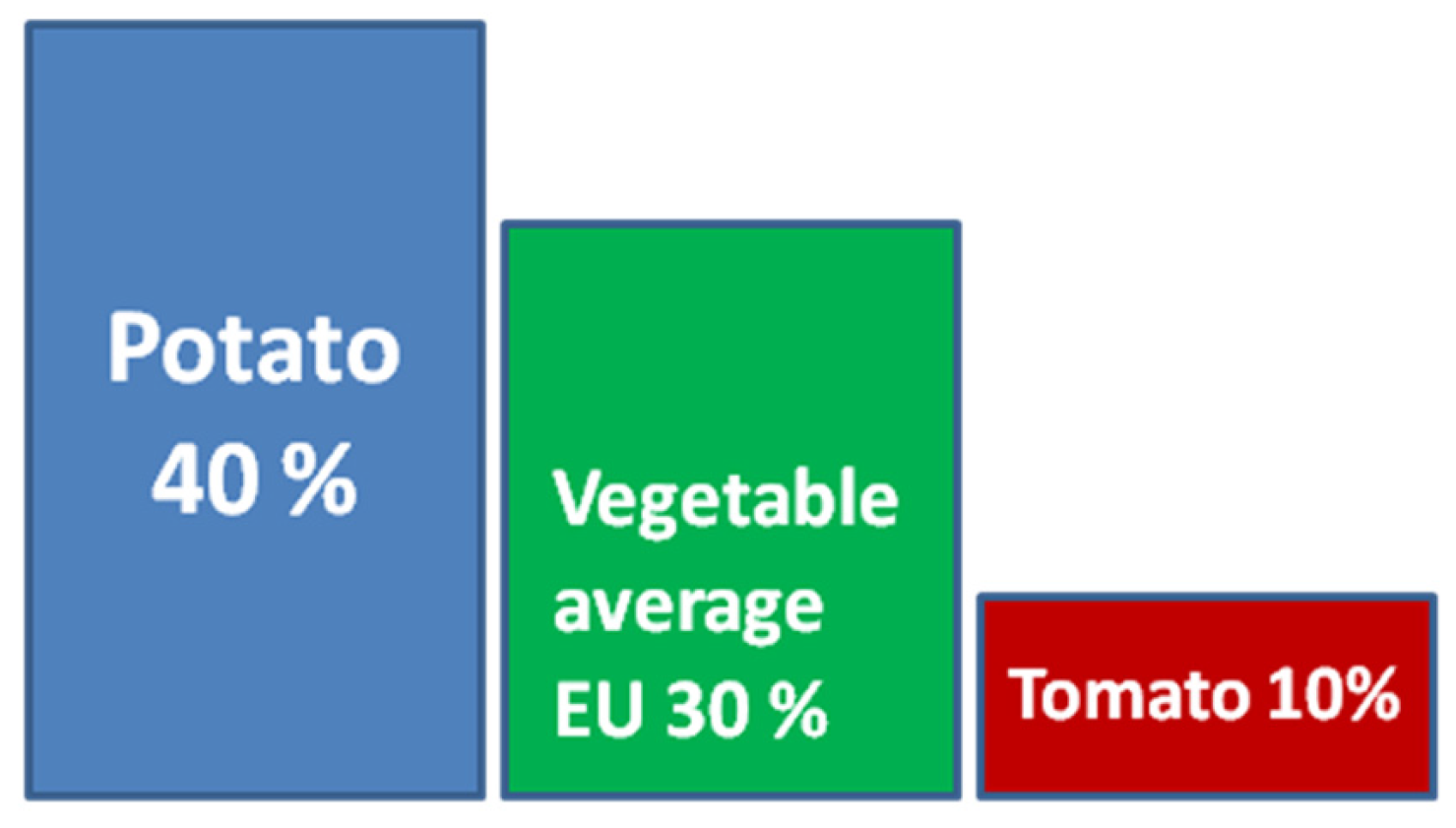Challenges of Reducing Fresh Produce Waste in Europe—From Farm to Fork
Abstract
:1. Introduction—Fresh Produce Left in the Field
2. Volumes of Fresh Produce Waste and Associated Financial Losses

| Source | Waste (Absolute Value in t/a) | Waste (Percentage) |
|---|---|---|
| Private households | 6,670,000 t | 61% |
| Canteens, restaurants | 1,900,000 t | 17% |
| Industry | 1,850,000 t | 17% |
| Trade-both wholesale and retail | 550,000 t | 5% |
| Total waste | 11 mil t | 100% |
3. Sources of Food Waste—A Key to Identifying Solutions and Avoiding Waste


| Commodity | Waste (absolute value (tonnes/year) | Waste that can be avoided (percentage) | Waste that can be avoided (absolute in tonnes/year) |
|---|---|---|---|
| Vegetables and salads | 1,600,000 t | 51% | 813,000 t |
| Fresh fruit | 910,000 t | 37% | 340,000 t |
| Potato | 5,900,000 t | 5% | 320,000 t |
| Total waste | 2,510,000 t | n.a. | 1,473,000 t |
| Countermeasure | Solution |
|---|---|
| Fruit breeding for low ethylene | Ethylene insensitive breeding lines (apple and tomato) |
| Blocking ethylene receptors | 1-MCP treatment before/after harvest |
| Cooling | Retards fruit ripening and ethylene emission |
| Replace combustion engines | use hand or electric fork lifts, vents etc. |
| Vents | Introduce fresh ambient air |
| Ethylene separator | Ethylene scrubber in fruit (CA/ULO) stores |
| Ethylene absorber | Sachets (Ryan /Sensitech Co.USA) or strips (It’s Fresh UK) in the punnet |
| Gas selective packaging film | “Peakfresh” packs (Peakfresh, Australia), or modified atmosphere packaging (MA) |
| Identify ethylene hot spots | any combination of the above |
| Potato and onion | Ethylene generation (“Restrain”) |
| Class I marketing | Whole crop purchase |
4. Five Approaches to Reduce Waste in the Field

4.1. Inhibitors of Ethylene Biosynthesis
4.2. Blocking the Ethylene Receptors to Extend Shelf-Life
4.3. Potato and Onion Storage with the Addition of Ethylene
4.4. Waste in the Field not Meeting Class I Marketing Standards
4.5. Whole Crop Purchase (WCP)
5. Four Approaches to Alleviate Waste in the Food Chain-Transport/Wholesale
5.1. Cooling
5.2. Venting
5.3. Inhibitor of Ethylene Receptors
5.4. Ethylene Absorbers and Scrubbers
6. Eight Approaches to Alleviate Waste at the Retail and Consumer Level
6.1. Supermarket
6.2. Canteens and Refectories
6.3. Consumer
6.4. Dedicated Recipes for Over-ripe Fruit
6.5. “Display until” or “Sell-by” Date
6.6. Sales of Class II Fruit
6.7. Food Sharing
| Causes | Countermeasure | Corrective Actions to be Taken | ||
|---|---|---|---|---|
| EU marketing standards-class I | Whole crops purchase (WCP) | “Purchase of the whole crop of the tree” or from the field | ||
| Deliberate sale of class II fruit | “Wunderlinge” in Billa (Sept. 2013) | |||
| “Display until” date (UK) | Abandon this practice | Less waste at super-market level | ||
| Food waste | Recipes including (over-) ripe fruit | Recipes including very ripe fruit | ||
| Food waste in private households | Food sharing | Left-over perishables in private households are offered for collection on social media | ||
| Food Waste at wholesale/retail | Die Tafel (Germany) | Volunteers collect left-over perishables from stores, canteens, airlines, restaurants etc | ||
6.8. ‘Die Tafel’ in Germany versus ‘Food Banks’ in the UK
7. Successful Countermeasures in Western Europe
8. Conclusions
Supplementary Materials
Acknowledgements
Conflicts of Interest
References
- Blanke, M.M. Perspectives of fruit research and apple orchard management in Germany in a changing climate. In Acta Horticulturae; Palmer, J., Ed.; ISBN 978-90-6605-531-5. ISHS: Korbeek-Lo, Belgium, 2007; Volume 772, pp. 441–447. [Google Scholar]
- Langley, J. Food for Thought?—A UK pilot study testing a methodology for compositional domestic food waste analysis. Waste Manag. Res. 2010, 28, 220–227. [Google Scholar] [CrossRef] [PubMed]
- Van Westerhoven, M.; Steenhuisen, F. Bepaling Voedselverliezen bij Huishoudens en Bedrijfscatering in Nederland; CREM: Amsterdam, The Netherlands, 2010. (In Dutch) [Google Scholar]
- BELV. Ermittlung der weggeworfenen Lebensmittel und Vorschläge zur Verminderung der Wegwerfrate bei Lebensmitteln in Deutschland; Institute für Abfallwirtschaft der Universitäten Stuttgart-Hohenheim und BoKu Wien: Stuttgart, Germany, 2012; p. 42. (In German) [Google Scholar]
- WRAP. Waste and Resources Action Programme, UK Government Watchdog on Waste Household Food and Drink Waste in the UK; Final Report 2009; WRAP: Banbury, Oxon, UK, 2009; ISBN 1-84405-430-6. [Google Scholar]
- Hill, R. Plan A: Product footprint. In Proceedings of the BSI Product Sustainability Conference, Drummond Gate, UK, 28 November 2013.
- Cofresco Frischehalteprodukte Europa. Das Wegwerfen von Lebensmitteln—Einstellungen und Verhaltensmuster. Ergebnisse Deutschland. Save Food Studie. Available online: http://www.cofresco.de/pdf/Results_Save_Food_Study_Germany.pdf.011 (accessed on 10 March 2015).
- WRAP. Waste and Resources Action Programme, UK Government Watchdog on Waste; WRAP: Banbury, Oxon, UK, 6 November 2013. Available online: http://www.wrap.org.uk/content/use-your-loaf-and-save-billions (accessed on 30 March 2015).
- Schaefer, F.; Blanke, M.M. Farming and marketing system affect carbon and water footprint of Hokaido pumpkin. J. Clean. Prod. 2012, 28, 113–119. [Google Scholar] [CrossRef]
- Sisler, E.C.; Serek, M. Inhibitors of ethylene responses in plants at the receptor level-recent developments. Physiol. Plant. 1997, 100, 577–582. [Google Scholar] [CrossRef]
- Bufler, G. Exogenous ethylene inhibits sprout growth in onion bulbs. Ann. Bot. 2009, 103, 23–28. [Google Scholar] [CrossRef] [PubMed]
- Rylski, I.; Rappaort, L.; Pratt, H.K. Dual effects of ethylene on potato tuber dormancy and sprout growth. Plant Physiol. 1974, 53, 658–662. [Google Scholar] [CrossRef] [PubMed]
- Mattheis, J.P.; Rudell, D.R. Diphenylamine metabolism in “Braeburn” apples stored under conditions conducive to the development of internal browning. J. Agric. Food Chem. 2008, 56, 3381–3385. [Google Scholar] [CrossRef] [PubMed]
- Wills, R.B.H.; Warton, M.A.; Ku, V.V.V. Ethylene levels associated with fruit and vegetables during marketing. Aust. J. Exp. Agric. 2000, 40, 485–470. [Google Scholar]
- Blanke, M.M.; Burdick, B. Food (miles) for thought-primary energy balance for locally-grown versus imported apple fruit. Environ. Sci. Pollut. Res.–ESPR 2005, 12, 125–127. [Google Scholar] [CrossRef]
- Coop vergrössert Ünique Sortiment. Coop Suisse 2015. Available online: http://www.coop.ch/pb/site/search/search/2057/Lde/index.html?qs=%C3%BCnique&fr=coop2012&search=search&backend=backend_coop2012&la=de&_sid=665f691e-1a51-45ed-9aa5-3938c44b8f68 (accessed on 25 June 2015).
- Foodsharing, 2015. Available online: https://foodsharing.de (accessed on 2 April 2015). (In German)
- Die Tafel. Available online: www.tafel.de (accessed on 3 February 2015). (In German)
- Schaefer, F.; Blanke, M.M. Opportunities and challenges for carbon footprint, climate or CO2 labels for horticultural products [-Nachhaltige Kennzeichnung klimafreundlicher Lebensmittel]. Erwerbs-Obstbau 2014, 56, 73–80. [Google Scholar] [CrossRef]
© 2015 by the authors; licensee MDPI, Basel, Switzerland. This article is an open access article distributed under the terms and conditions of the Creative Commons Attribution license (http://creativecommons.org/licenses/by/4.0/).
Share and Cite
Blanke, M. Challenges of Reducing Fresh Produce Waste in Europe—From Farm to Fork. Agriculture 2015, 5, 389-399. https://doi.org/10.3390/agriculture5030389
Blanke M. Challenges of Reducing Fresh Produce Waste in Europe—From Farm to Fork. Agriculture. 2015; 5(3):389-399. https://doi.org/10.3390/agriculture5030389
Chicago/Turabian StyleBlanke, Michael. 2015. "Challenges of Reducing Fresh Produce Waste in Europe—From Farm to Fork" Agriculture 5, no. 3: 389-399. https://doi.org/10.3390/agriculture5030389
APA StyleBlanke, M. (2015). Challenges of Reducing Fresh Produce Waste in Europe—From Farm to Fork. Agriculture, 5(3), 389-399. https://doi.org/10.3390/agriculture5030389






